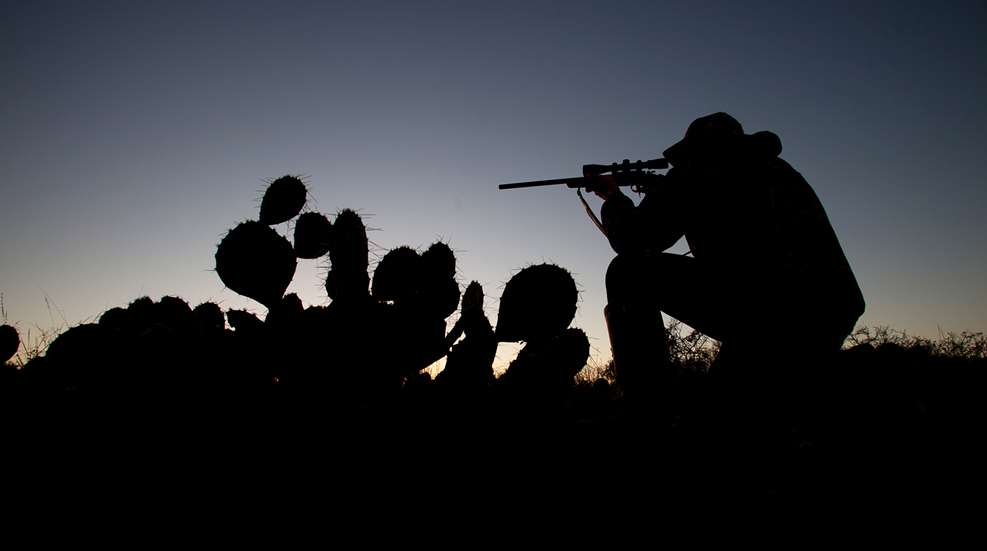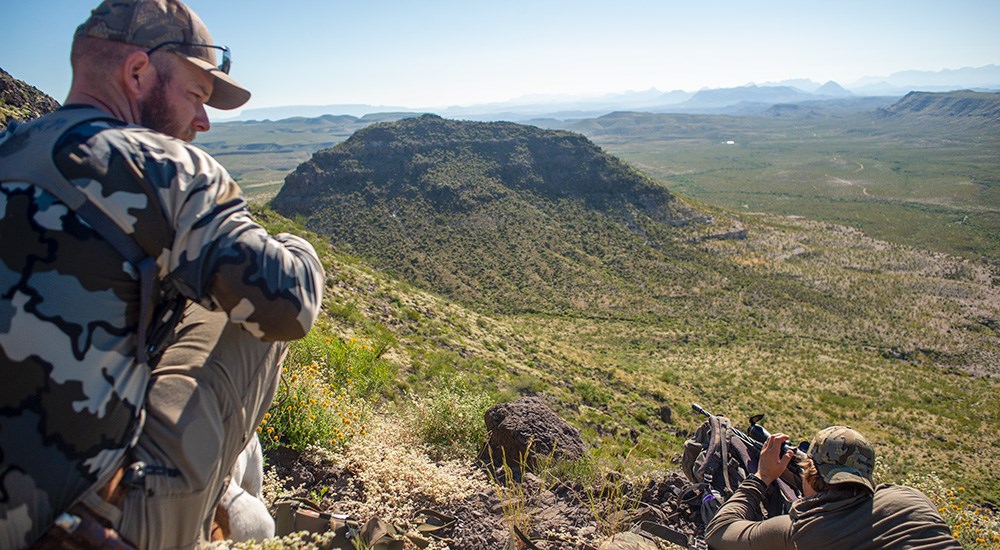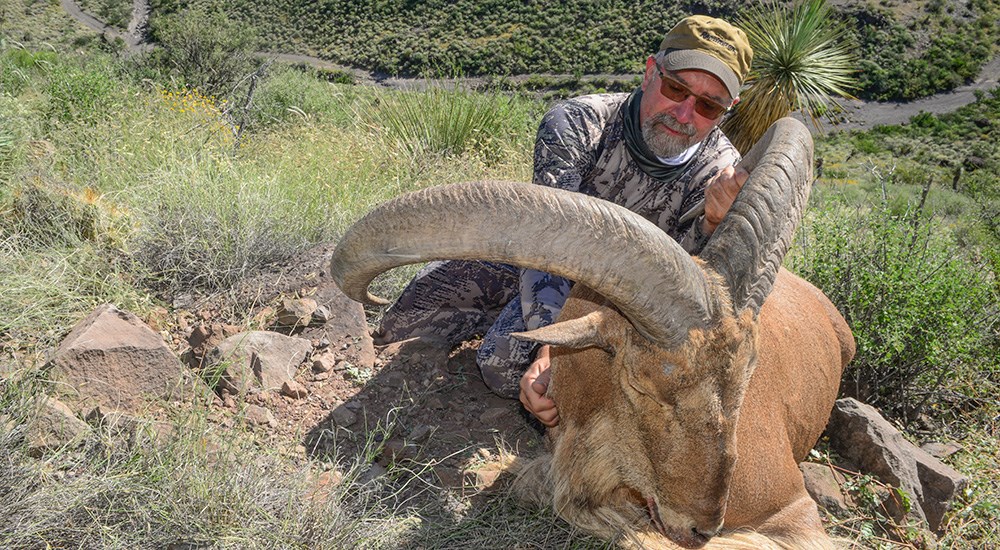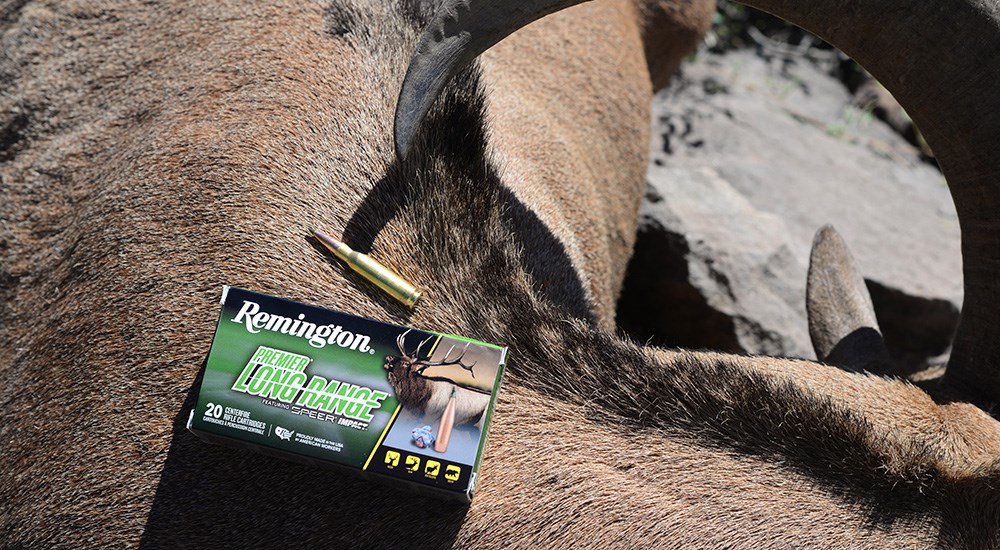
Cross Moody drove as far as he could then parked the truck. “We’ll walk from here,” he said. We’d driven maybe a mile from where we first spotted the band of sheep on a distant, rocky mountainside. Now three of us loaded up, knowing we wouldn’t walk far, maybe a half-mile. We needed to cut the distance as much as possible before assessing a possible shot on the ram in the group Cross had decided was worthy of our attention. We’d never be able to close within a hundred yards of the ram. He and his band lounged comfortably on their perch high above the valley floor. Aoudad, also called Barbary sheep, possess incredible eyesight and an uncanny ability to negotiate mountain terrain—same as any sheep or goat. With these tools, the species uses distance and altitude to thrive and survive.
I always like it when I am the first to see the game I will shoot, and it occurred to me this was one of those times and it felt good. Didn’t necessarily mean anything mind you, because the truth is I was simply the first one to say something about the band of sheep way up on the far off hillside when we spotted them through binoculars from behind a windshield “way back there.”
We strode down the dry creekbed, using the topography and the desert flora to stay in the shadows. We hiked as far as we could then decided to set up. Chase and I dropped to all fours and crawled around the corner, onto the soft sandy bed. Joel Hodgdon of Remington stayed behind, and stood comfortably in the shadows, where he could peer over the sage in front of him and watch the scene unfold on the ground before him and on the mountainside hundreds of yards away. I slipped off my pack, hunched forward and pushed it before me, gripping my rifle suitcase-style between the thumb and forefinger of my right hand so as to point the muzzle sidewise and not at my guide’s back.

We couldn’t avoid the sunlight for long. After 10 yards we stopped crawling and, through binoculars propped on elbows, peered at the aoudad on the mountain. They had not seen us settle here. The range was 450 yards. This would do. It was time to build my house.
It’s always best to assess the terrain and the amount of time you may have to set up a shot before settling into a firing position. You may climb out of a truck to take a “gimme” shot just yards away from the two-track. You may stalk game over hill and dale then find time to use a tree or a fencepost or a pair of sticks as a rifle rest. But during that stalk, you may crest a ridge and spook game below you, and have precious little time to do anything but heed the guide when he pleads, “Shoot!” It’s best to mull the possibilities at all times.
In this case the decision was made for me. I would shoot prone. It is the best, most stable position, after all, so I wasn’t complaining. I always say never stand when you can kneel, never kneel when you can sit, never sit when you can go prone. Above all never take a shot without help. If adding a shooting rest—a pack, a sandbag, a pair of sticks, a buddy leaning against you—takes out wobble, take the help. When you have the time make the most of it. But never forget you may not have time for second choices. Know before you drop into position.
I pushed my pack before me, fluffed up the contents inside it and dropped the fore-end of the Kimber Longmaster Classic .308 Winchester atop it. I didn’t have the height needed on the muzzle so I added a bit more padding. I settled in behind the eyebox of the Leupold Mark 4 2.5-8x-36mm MR/T then adjusted to find a natural shooting position—the right geometry to ensure my body lined up with the direction of my muzzle. My elbows settled naturally to either side; I dug them into the soft gravel to find the right angle that wouldn’t cause pain in my trapezius muscles. Then I spread my legs as far as they would go, dropped my heels inward and pointed my toes outward. You never want to leave your heels “flying,” where they are susceptible to involuntary movement due to your breathing, the wind or fatigue.
Everything felt good, so it was time to focus on the shot.
“Four hundred fifty yards,” Chase repeated as I pulled my range card from a breast pocket.
This was my first time firing at game with Remington’s new Premier Long Range ammunition loaded with Speer Impact bonded bullets. The day before, when we checked zeroes on a landing strip near the bunkhouse, I insisted on taking a couple shots at distance. I knew the rifle and ammo were good at a hundred. I’d seen that in Virginia then again here. But as I lay prone and fired at 400 yards, it became clear something was wrong. This is why it’s always best to “walk it out” on a long-range hunt.
We were hunting the Trans-Pecos in West Texas south of Marfa. In fact we were way, way south of Marfa, only miles from the Mexican border. This is the desert of Texas. Here there are mountains and sand hills, forbidding buttes, desert valleys and desert brush land. Rain does not fall evenly here, when it does fall. Soils are mostly alkaline. Caliche is common due to the high content of calcium in the soil. Vegetation includes honey mesquite, red berry juniper, hackberry, Mexican buckeye, cottonwood and shin oak and succulents like cacti, yuccas and agaves.
On its website High West Outfitters warns: “This is a real sheep hunt, so your gear list can be very important for your success and comfort. One can expect long-range shots ranging from 250-500 yds. Practice shooting before you come!!!” That part I did—always do before a hunt. But in Virginia I had no place to shoot past a hundred. So on the airstrip I dialed out to 200, 300 and finally 400 yards. Everything felt good, all the clicks in the Leupold worked until I got to 400. At that distance we saw only dust fly. No Speer bullets hit the target. My guide, Cross, saw the pen in my hand. I was ready to record some new DOPE (data on previous engagements) to rebuild my range card when he said, “Wait a minute. We’re thinking.”

Then I realized what he and the other guides were pondering. The airstrip was not exactly level. My shots from prone were bouncing off gravel before they made it to the target. I had to use the hood of a pickup as a rest to get the height needed to send a bullet to the target at 400 yards, but when it smacked home I proved to myself and my guide that I and my rifle and my ammo could perform as needed on a “real sheep hunt.”
Now, as I lay in the soft gravel next to my guide, I dialed the elevation turret on the Leupold Mark 4 scope 8.99 MOA to account for a 450-yard flight. There was no wind; a hold-off wouldn’t be needed.
Then we waited.
The aoudad on the mountain lounged. Most lay on the ground. Some stood. The ram we targeted was lying down, so with no shot I had to save my neck from strain. Chase would keep an eye on the ram until it gave us a shot.
My position was awfully solid, but it wasn’t perfect. Shots afield rarely are perfect. I was lying prone and aiming uphill at a pretty steep angle. I just couldn’t stay behind the scope for any length of time. It reminded me of another shot long ago.
I was in South Africa on my first safari, shooting at my first zebra. The shot was a couple of hundred yards—not too long. But I was lying prone, pointed downhill, and the game was standing uphill from me. The position was just about the worst. Well, there are worse, but still—it was bad. I seemed to lie there forever until the mare presented a shot. By then the pain in the back of my neck was almost unbearable. In fact the next day it was unbearable. Thereafter I called that kind of pain “zebra neck.” Right now, in Texas, I wanted to avoid zebra neck.
It took a while, but finally Cross whispered, “OK … see what you think.”
I lifted my head and peered through the scope. The ram had moved from behind a yucca, so I began to punch my list: breathe, relax, aim, stop, squeeze, follow through. It’s what I was taught in the Marine Corps and the mantra has not failed me so long as I’ve done my part over the years. Of course after 10 minutes looking at the sandy gravel mere inches from my face I didn’t need more relaxation, so I cut to the important parts: breathe, focus on the sight picture of the reticle on the ram’s shoulder then squeeze … and follow through.
The rifle barked and the ram skipped a step or two but otherwise nothing happened. “I think you missed,” said Cross. Damn. Everything felt good. The .308 doesn’t rock me; I’d followed through without losing my view through the scope. I just couldn’t imagine … but there was no time to analyze it. The ram just stood there. In fact everybody up there seemed calm despite the report of the rifle and the bullet that must’ve bounced off rocks right next to the ram. If I wanted this ram I needed to develop a short-term memory, so I worked the bolt quickly but quietly and prepared to shoot again. Focus, breathe … blam.
The ram fell, but it didn’t die for some time. The rest of his band trotted over the mountain. It would take us half an hour to get up there so we didn’t dare move. Every hunter knows that’s when the “dead ones” get up and trot over the horizon. So we were forced to lie there and watch through the glass as the mighty ram, sprawled on his back, kicked out his last breath. That seemed to take some time and the truth is I’m not sure how long it lasted. I remained prepared to shoot again, but I just couldn’t see an angle for a bullet that would do anything but maim him, so I couldn’t press the trigger again. As I watched the last bit of life escape him I felt, as always, the quickening that lies at that intersection of melancholy, reverence and pride.
Remington Premier Long Range
Perhaps I should have used something besides a .308 Winchester to demonstrate the worth of Remington’s new long-range ammo. Many cartridges fly flatter at long range, after all, but I don’t regret my choice. I like my Kimber Longmaster Classic .308. I call it my “peas-and-carrots rifle,” as in that rifle and I go together like peas and carrots. With it I have taken many rifle courses; with it I am good to 800 yards on paper and steel. With it I have taken game out to 300 yards, and now an aoudad at 450 yards.
Premier Long Range is the first factory ammo loaded with Speer’s Impact bonded bullet. The bullet’s patented Slipstream tip initiates expansion at velocities 200 fps slower than standard polymer tips to ensure performance at long range. Its boattail base ensures a high ballistic coefficient along with all the benefits of match-grade accuracy. Bonded construction fuses the jacket and core to prevent separation and deliver maximum weight retention and thus excellent terminal energy. This is Remington’s highest-quality big-game ammo yet.

My 450-yard shooting solution came from my second range card. Before I arrived, I’d checked out West Texas on a map; I figured I’d hunt at altitude but I wasn’t sure. So I built two range cards: one for sea level, the other for 6,000 feet. Turns out we hunted at about 4,500 feet, so the 6,000-foot card worked best. Just to be clear, 8.99 MOA on a .308 Win. is 42.4 inches of drop. Whew—that’s a lot. Perhaps I should have chosen to carry my custom 7mm Rem. Mag., but that gun weighs a ton and this was a sheep hunt and besides, as I said the Kimber and I go together like peas and carrots.
Premier Long Range is now loaded in 10 calibers: 6.5 Creedmoor, 6.5 PRC, .270 Win., .308 Win., .30-06 Sprg., 7mm Rem. Mag., 7mm PRC, .300 Win. Mag., .300 RUM and .300 PRC. I’m looking for a hunt this fall to use this ammo in 6.5 PRC.


































